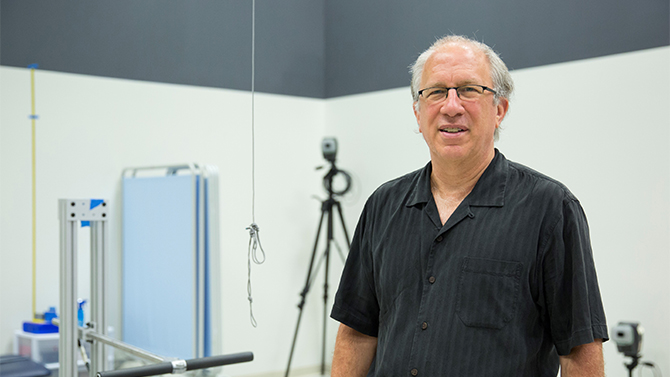


KAAP chair named
June 21, 2017
Neuroscientist Jeka chairs Department of Kinesiology and Applied Physiology
The University of Delaware Department of Kinesiology and Applied Physiology (KAAP) has a new chairperson. John Jeka, a neuroscientist and distinguished researcher, has been selected to lead the department.
When considering UD, the Science, Technology and Advanced Research (STAR) Campus and the College of Health Sciences’ strong presence were the real attractions for Jeka.
“STAR Health is a model that holds interesting promise to changing the landscape of health care,” Jeka said.
With personal research interests in neuroscience, balance, locomotion and wearable technology, he saw unique potential.
Jeka had many existing, longstanding relationships with UD researchers long before he arrived in Newark and said, “This place is very focused on my area of research. I have more potential collaborators here than anywhere on the planet.”
Jeka said he has big plans for his already fast-rising department. He sees an existing, interdisciplinary research group — the Center for Biomedical Research Excellence (COBRE) — as a model worthy of replication throughout his department.
“Dave Edwards and [former KAAP chairperson] Bill Farquhar formed a team that is exactly what modern science is about,” Jeka said. “You have a broad research area that you address certain issues. Everyone on the team has their component with a common set of goals and strategies.”
An impressive research portfolio
In addition to his duties as chairperson, Jeka comes to UD with an impressive research portfolio. He is extremely passionate about problems related to the neural control of movement. He studies how people use sensory information (like vision and the inner ear) to achieve upright balance — something that Jeka says people take for granted.
“We all walk around somewhat nonchalantly, but, as people age or experience neurological trauma, you realize that there is a sophisticated control system allowing you to do this wonderful thing called bipedal walking. We are able to stay upright as we encounter different surfaces, such as when you transition from a hard sidewalk to a soft beach without thinking about it,” he said.
But within the intricacies of the human brain, the nervous system is working hard behind the scenes to ensure these smooth transitions. With age comes deteriorations in balance. And comprised balance leads to one of the most dreaded words in health care — falls. Nationally, the treatment of fall-related injuries costs upwards of $20-30 billion.
“You are constantly taking in sensory information to know where you are in the world and how you want to move forward,” Jeka said. “Without that information, our nervous system cannot activate our muscles appropriately and even standing still would be impossible.”
So Jeka and his research team investigate sensory information and how people balance during standing and walking. They apply their findings to many different patient populations, including people with inner ear issues, Parkinson’s disease and traumatic brain injury.
His research team receives funding from the National Institutes of Health to devise ways to understand what leads people to fall, develop new interventions and design assistive devices. For example, the team created a patented wrist-worn device for people with Parkinson’s called ArmSense. As the disease progresses, one of the problems with Parkinson’s is festinated gait, in which a person walks with short, choppy steps while their arms lay rigid at their side.
“As your steps become short and stiff, it becomes a downward spiral where you are less and less mobile. The ArmSense device essentially measures the position of your arm in space. And we’ve added haptic feedback [like a cell phone vibration] to target a certain, extended arm swing,” Jeka said.
A person with Parkinson’s works on swinging his or her arm until the buzz is felt on the wrist, which reinforces the need to increase the arm swing without having to think about it. The improved arm motion positively effects all sorts of gait parameters, and the individual begins to step more like a person with a healthy gait.
“People with Parkinson’s can improve their gait,” he said. “It’s just that their perception of their movement is poor. This is a device that people can take home with them, so improved gait doesn’t just happen when they’re in a clinic. It happens in their daily lives.”
Research team
Jeka has already recruited a talented group of young researchers to work with him at UD. They include:
• Assistant professor Matt Hudson, a physiologist who studies molecular mechanisms of muscle function;
• Postdoctoral fellow Hendrik Reinmann, who specializes in math, robotics and motor control;
• Postdoctoral fellow Jaclyn Cacesse, who specializes in concussion and is a former UD biomechanics graduate student;
• Doctoral student Tyler Fettrow; and
• Doctoral student Fernando Vanderlinde dos Santos.
Contact Us
Have a UDaily story idea?
Contact us at ocm@udel.edu
Members of the press
Contact us at 302-831-NEWS or visit the Media Relations website

